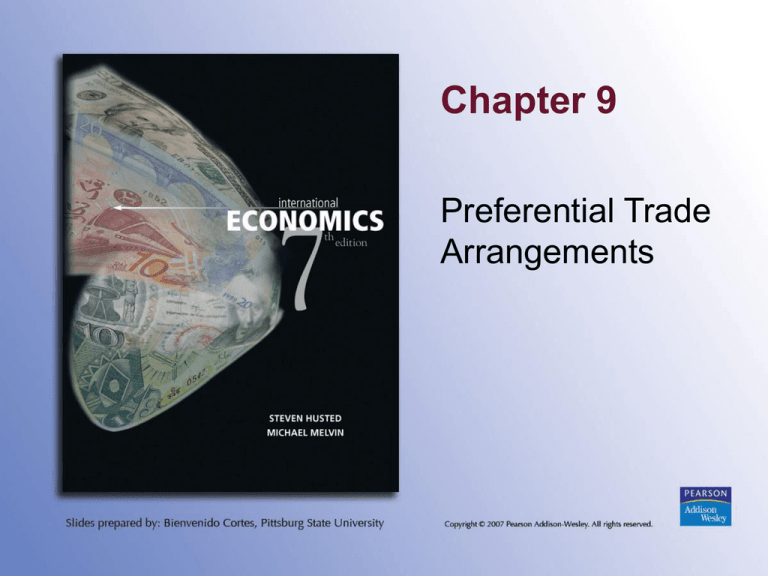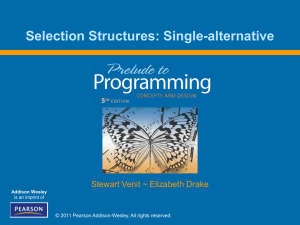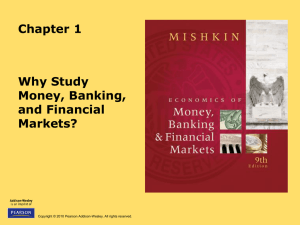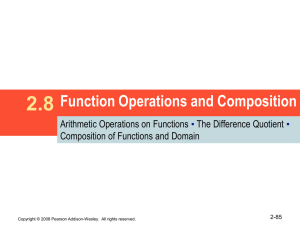
Chapter 9
Preferential Trade
Arrangements
Topics to be Covered
• Types of Preferential Trading Arrangements
Free-Trade Area
Custom Union
• Trade Diversion
• Trade Creation
• NAFTA and the U.S. Economy
• European Union
• Regionalism vs. Multilateralism
Copyright © 2007 Pearson Addison-Wesley. All rights reserved.
9-2
Preferential Trade Arrangement
• Agreement where countries join together
to form a trade bloc with special
relationships among the members
• Types of trade arrangements
• Effects of trade arrangements
Copyright © 2007 Pearson Addison-Wesley. All rights reserved.
9-3
Types of Trade Arrangements
• Free-trade Area (FTA)—members
agree to eliminate trade barriers among
themselves, but maintain individual
barriers against non-members
(ex., NAFTA).
• Customs Union (CU)—members remove
trade barriers among themselves
and form common barriers among nonmembers (ex., EU).
Copyright © 2007 Pearson Addison-Wesley. All rights reserved.
9-4
Other Types
• Common Market—a customs union that
has freedom of movement for all factors
of production within the area defined by
the member states.
• Economic Union—a common market
plus unification and harmonization of all
economic policies and institutions.
Copyright © 2007 Pearson Addison-Wesley. All rights reserved.
9-5
European Union
• Formed in 1957 as CU among 6 countries
(France, West Germany, Italy, and
Benelux nations).
• Has added 19 members since:
UK, Ireland, & Denmark (1973)
Greece (1981)
Spain & Portugal (1986)
Austria, Finland, & Sweden (1995)
Cyprus, Czech Republic, Estonia, Hungary,
Latvia, Lithuania, Malta, Poland, Slovakia &
Slovenia (2004)
Copyright © 2007 Pearson Addison-Wesley. All rights reserved.
9-6
European Union (cont.)
• EU population is over 450 million people.
• EU countries as a group are largest exporter
and importer in the world.
• EU was first called European Common
Market, then the European Community
(1958), and now the European Union (1993).
• Theoretically, EU is a sort of united states
of Europe.
Copyright © 2007 Pearson Addison-Wesley. All rights reserved.
9-7
North American
Free Trade Agreement
• NAFTA consists of the U.S., Canada,
and Mexico
• Went into effect in January 1, 1994
• Was an expansion of an existing
US–Canada FTA to include Mexico
• Also includes agreements on
environmental, labor, and intellectual
property rights issues
Copyright © 2007 Pearson Addison-Wesley. All rights reserved.
9-8
Economic Analysis of
Preferential Trade Arrangements
• Assume there are three countries
(A, B, and C) in the world
• A is the world’s high-cost producer of
beer; A is a small country
• C is the world’s low-cost producer
of beer
Copyright © 2007 Pearson Addison-Wesley. All rights reserved.
9-9
Insert Figure 9.1 here
Free Trade Effects
• A imports beer from C
• Consumer surplus
• Producer surplus
Copyright © 2007 Pearson Addison-Wesley. All rights reserved.
9-11
Tariff Effects
• A protects its producers with 100%
ad valorem tariff
• A continues to import beer only from C
• Price effect
• Import effect
• Government revenue effect
• Other effects
Copyright © 2007 Pearson Addison-Wesley. All rights reserved.
9-12
Effects of FTA between A and B
• Trade Diversion—a shift in the pattern
of trade from low-cost world producers
to higher-cost FTA members;
welfare-reducing effect.
• Trade Creation—an expansion in world
trade resulting from formation of an FTA;
welfare-increasing effect.
Copyright © 2007 Pearson Addison-Wesley. All rights reserved.
9-13
Welfare Effects of FTA between
Countries A and B
Copyright © 2007 Pearson Addison-Wesley. All rights reserved.
9-14
FTA Welfare Effects on A
• Price falls
• Consumer surplus rises
• Producer surplus falls
• Government revenue falls
• Net welfare impact of $(b + d) – $e
Trade creation gain (b + d)
Trade diversion loss (e)
Copyright © 2007 Pearson Addison-Wesley. All rights reserved.
9-15
FTA Effects on B and C
• Country B gains due to new export
market in A
• Country C loses because its producers
have lost its market in A
Copyright © 2007 Pearson Addison-Wesley. All rights reserved.
9-16
What Happens If
A Forms FTA With C?
• Pure trade creation as A’s imports from C
return to free trade levels
• Zero trade diversion since, both before and
after FTA, country A trades only with C
• A’s welfare gains are $(b + f + g + d + h + i)
• C gains due to rise in exports
• B neither gains nor loses (trade unaffected)
Copyright © 2007 Pearson Addison-Wesley. All rights reserved.
9-17
Why Would A
Form FTA With B Instead of With C?
• Dynamic gains resulting from
economies of scale
• Political reasons
Copyright © 2007 Pearson Addison-Wesley. All rights reserved.
9-18
NAFTA
• NAFTA came into effect in January 1994
• By 2008, it will lead to virtual free trade
• Mexico’s pre-NAFTA experience:
Growth via import-substitution policies
Budget deficits & inflation in 1970s
Huge foreign debt by early 1980s
De la Madrid’s anti-inflation reforms
Reduction of trade barriers and FTA talks
under Salinas
Copyright © 2007 Pearson Addison-Wesley. All rights reserved.
9-19
NAFTA (cont.)
• Canada joined US–Mexico FTA talks in
early 1990s.
• NAFTA signed by US, Mexico, and
Canada leaders in December 1992, but
without Congressional approval.
• Environmental and labor issues
added by Clinton administration, and
agreement signed in 1993.
Copyright © 2007 Pearson Addison-Wesley. All rights reserved.
9-20
Why is NAFTA Controversial?
• Standards of living (i.e., GDP per capita)
are different among the three countries.
• Lower wages in Mexico (one-tenth of
U.S. and Canada wages) may lead to a
loss in U.S. manufacturing jobs.
Copyright © 2007 Pearson Addison-Wesley. All rights reserved.
9-21
NAFTA Country Characteristics
Copyright © 2007 Pearson Addison-Wesley. All rights reserved.
9-22
What Accounts for
Mexico’s Low Productivity Levels?
• Largely untrained Mexican workers
• Small scale of manufacturing operations
• Poor infrastructure
• Shortage of qualified managers
• Limited capital goods
• Unreliable legal system
Copyright © 2007 Pearson Addison-Wesley. All rights reserved.
9-23
Effects of NAFTA on U.S. Economy
• After 12 years, very little impact
• U.S. trade with Mexico has grown, but
so has U.S. trade with other countries
• Impact on jobs is relatively small given
the size of U.S. employment
Copyright © 2007 Pearson Addison-Wesley. All rights reserved.
9-24
Why the Small Impact of NAFTA on
the U.S.?
• U.S. trade barriers are already low
• Mexican economy is small relative to the
U.S. economy
Copyright © 2007 Pearson Addison-Wesley. All rights reserved.
9-25
European Union
• EU is world’s largest custom union
• 25 current member countries with
various candidate nations (Bulgaria,
Romania, Turkey, Croatia, Macedonia)
• Ultimate goal: to become “united states
of Europe”
Copyright © 2007 Pearson Addison-Wesley. All rights reserved.
9-26
In Pursuit of EU’s Ultimate Goal
• Single European Act (1986)—act passed by
EU to remove various non-tariff trade barriers
by the end of 1992.
• Economic and Monetary Union (EMU)—
adoption in 1999 of a common currency called
the euro; 12 of the 25 member nations
participate in the EMU.
• Other agreements involve a new social
charter, common foreign and defense policies,
and worker rights.
Copyright © 2007 Pearson Addison-Wesley. All rights reserved.
9-27
The EU Government
• Headquarters in Brussels, Belgium
• Four institutions:
European Commission
Council of the EU
European Court of Justice
European Parliament
Copyright © 2007 Pearson Addison-Wesley. All rights reserved.
9-28
European Commission
• One of two executive offices of the
EU government
• Its primary task is to draft and enforce
EU laws
• It represents the EU in international
trade negotiations
• It consists of 25 members, one from
each country, and is headed by a
president and six vice-presidents
Copyright © 2007 Pearson Addison-Wesley. All rights reserved.
9-29
Council of the EU
• Second executive office of the
EU government
• Each EU country has one
representative, usually its
foreign minister
• It has power to decide about European
Commission proposals and to
issue directives and regulations to
member states
Copyright © 2007 Pearson Addison-Wesley. All rights reserved.
9-30
European Court of Justice
• Chief judiciary body of the EU
• Decides on the legality of European
Commission or Council of the EU
actions with respect to EU treaties
Copyright © 2007 Pearson Addison-Wesley. All rights reserved.
9-31
European Parliament
• Legislative branch of the EU government
• Chief representative of the people in the
process of setting EU policies
• Consists of 732 members, each elected for
5-year terms
• Number of representatives is based on
population and size of economy:
Germany (99)
France, Italy, and UK (78 each)
Spain and Poland (54 each)
Copyright © 2007 Pearson Addison-Wesley. All rights reserved.
9-32
European Parliament (cont.)
• Administrative seat is in Luxembourg and in
Strasbourg, France
• Has limited powers:
Can scrutinize but not initiate legislation
Can make suggestions regarding European
Commission proposals
Can amend some EU budget expenditures
Can amend council actions regarding Single
European Act
Has veto power over applications of
candidate countries
Copyright © 2007 Pearson Addison-Wesley. All rights reserved.
9-33
Regionalism vs. Multilateralism
• Regionalism—where countries lower
trade barriers only for a small group of
partner or neighboring countries and
discriminate against the rest of the world
(refer to Item 9.2 for RTA examples).
• Multilateralism—non-discriminatory
basis of the World Trade Organization.
Copyright © 2007 Pearson Addison-Wesley. All rights reserved.
9-34
Arguments Against Regionalism
• Bhagwati views the formation of regional
trade arrangements (RTAs) as
undermining the WTO
• Regionalism is harmful because it
encourages trade diversion
Copyright © 2007 Pearson Addison-Wesley. All rights reserved.
9-35
Arguments Favoring Regionalism
• Krugman argues that trade diversion
from FTAs is low because trading blocs
are “natural” trading areas
• Due to proximity and similarity of
cultures and standards of living, regional
trade agreements stimulate trade that
would have occurred even in the
absence of an agreement
Copyright © 2007 Pearson Addison-Wesley. All rights reserved.
9-36








